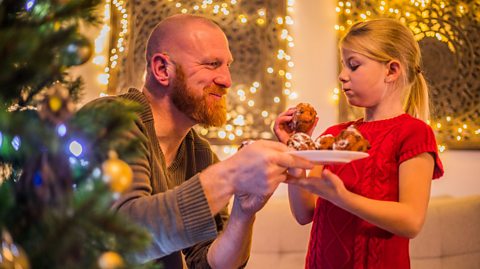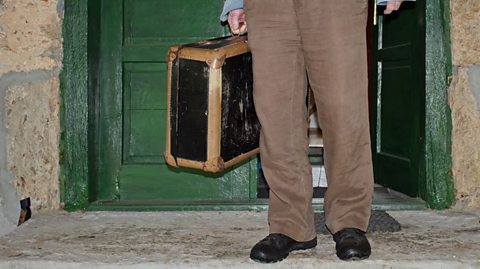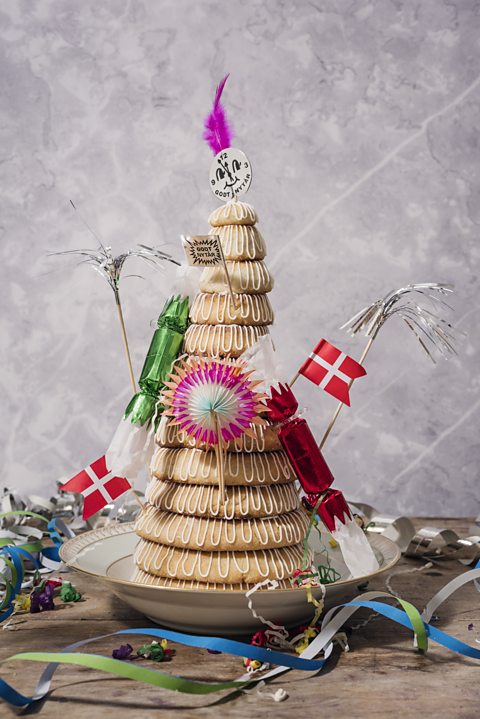When the clock strikes midnight on 31 December, you may hug someone close to you and wish them a Happy New Year.
Then again, you may not be able to as your mouth is full of a delicious ball of dough, or youÔÇÖre too busy delivering a lump of coal.
Why? These are just some of the New Year traditions observed in different parts of the world. Join ┤¾¤¾┤½├¢ Bitesize on a series of journeys into 1 January - in the UK and further afield.
What is oliebollen and why is it so popular in the Netherlands?
December in the Netherlands can get very, very cold. So what better way to warm (and cheer) yourself up than a bit of carbs dipped in sugar?
An oliebol - which translates as ÔÇÿoil ballÔÇÖ, but please donÔÇÖt be put off by that - is a ball of raisins in dough fried in oil and then dipped in sugar. Having oliebollen - the plural of oliebol - at New Year is now a Dutch tradition. Families either make them to their own recipe or street sellers can have lines of customers waiting to buy them fresh.

Oliebollen history is tricky to pin down, but they do feature in a 1652 painting by the Dutch landscape artist Aelbert Cuyp, and a recipe has been traced to a 1667 cookbook. The origins of enjoying them at New Year are also unclear. One theory is that it dates back to the Middle Ages, when the rich handed them out to the poor, in the hope their generous act would be rewarded with good fortune over the coming year.
What is first footing and why is it so popular in Scotland?
New year celebrations in Scotland are an important part of the calendar. The festivities are called Hogmanay and last three days in all - 2 January is usually an extra bank holiday in Scotland, depending on which day of the week New Year's Day falls.
One of the biggest Hogmanay traditions is first footing. It is said that having a tall, dark-haired man as the first visitor to your home of the new year will bring good luck. Usually, an ideal first footer candidate is sent out of the house just before midnight, then returns after the bells have chimed. Ideally, they will be carrying symbolic gifts for their host.
Professor Donna Heddle of the University of the Highlands and Islands told the ┤¾¤¾┤½├¢ in 2012: ÔÇ£All these gifts were symbolic wishes for the new year to come. Coal for heat, whisky for good cheer and hospitality, while shortbread and black bun, a rich cake, symbolised good food all year.
"Salt is particularly significant. Salt is a symbol of friendship. Traditionally, hospitality is referred to as sharing bread and salt.ÔÇØ
Although it is predominantly a Scottish custom, first footing is popular in parts of England as well as the Isle of Man and other countries, including Greece.
Why do they carry suitcases in Colombia at New Year?
It may seem a little cumbersome, but it's one of many New Year traditions in Colombia to carry an empty suitcase around on 31 December.
The idea is that having an object so closely associated with travel with you is good luck, and will lead to 12 months of fulfilling adventures.

It isn't the only tradition observed in Colombia at this time of year. Another is to fill your pockets with dry lentils as it's believed to bring future success. Lentils also crop up in the traditions of other countries. Eating them at New Year is considered good luck in Italy, a tradition also observed in some South American countries, such as Brazil.
Another Colombian tradition marked in other countries is the eating of a grape for each chime of midnight as 1 January arrives. This is a big part of the New Year celebrations in Spain, where it's called las doce uvas de la suerte (the twelve grapes of luck). Making a wish as you eat each grape can be part of the tradition too - just make sure you're well prepared beforehand with 12 grapes and 12 wishes!

WhatÔÇÖs with all the jumping in Denmark on New YearÔÇÖs Eve?
Denmark has a number of New Year traditions and it all starts with the annual speech given by the reigning monarch. It airs at 6pm on Danish television and is often seen as a sign for the festivities to begin.
Similar to the QueenÔÇÖs Christmas Day speech in the UK, itÔÇÖs a broadcast watched by a large percentage of the population and there is often speculation on which topics will be covered.
As long as it's safe to do so, people jump off chairs at midnight as a sign of ÔÇÿleapingÔÇÖ into another year. They also enjoy a slice of kransekage, a cake created from rings of baked marzipan.
The recipe for Paul HollywoodÔÇÖs version of a kransekage can be found on the ┤¾¤¾┤½├¢ Food website.
This article was published in December 2021.

Fed up of regular New Year's resolutions? Find out how to have a more mindful start to the new year.

What itÔÇÖs like being autistic on New YearÔÇÖs Eve
Fireworks aren't fun for everyone - we speak to one person to find out why.

Bank holidays: Where do they come from?
Agriculture, religion and national identity have all played a role in creating holidays.
